 W
WThe Southern Carpathians are a group of mountain ranges located in southern Romania. They cover the part of the Carpathian Mountains located between the Prahova River in the east and the Timiș and Cerna Rivers in the west. To the south they are bounded by the Balkan mountain range.
 W
WThe Apuseni Mountains is a mountain range in Transylvania, Romania, which belongs to the Western Romanian Carpathians, also called Occidentali in Romanian. Their name translates from Romanian as Mountains "of the sunset", i.e., "western". The highest peak is the Bihor Peak at 1,849 metres (6,066 ft). The Apuseni Mountains have about 400 caves.
 W
WThe Baiu Mountains are mountains in central Romania, a few kilometers south of Brașov.
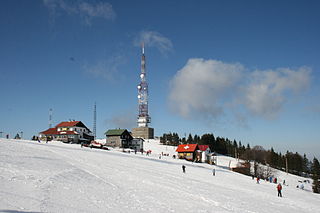 W
WThe Banat Mountains are a number of mountain ranges in Romania, considered part of the Western Romanian Carpathians mountain range.
 W
WThe Baraolt Mountains is a mountain range, entirely in Covasna County of Romania.
 W
WBihor Mountains is a mountain range in western Romania. It is part of the Apuseni Mountains, which are part of the Carpathian Mountains. The massif has a length of 25 kilometres (16 mi) from the northwest to the southeast and a width of 14 kilometres (8.7 mi). It is located east of the town Ștei, and north of the town Brad.
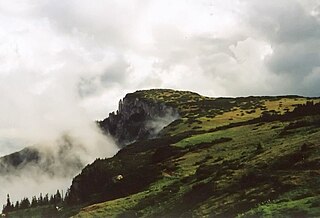 W
WThe Bistrița Mountains are mountain ranges in northern central Romania.
 W
WThe Bucegi Mountains are located in central Romania, south of the city of Brașov. They are part of the Southern Carpathians group of the Carpathian Mountains. At 2,505 m (8,219 ft), Omu is its highest point.
 W
WThe Buzău Mountains are a set of five mountains ranges in Romania which are part of the Curvature Carpathians region of the Outer Eastern Carpathians.
 W
WThe Căliman-Harghita Mountains are a group of mountain ranges in Romania.
 W
WThe Călimani Mountains are the largest volcanic complex of the Carpathian Mountains in Transylvania, Romania. Geologically they belong to the Căliman-Harghita Mountains group of the Inner Eastern Carpathians.
 W
WThe Carpathian Mountains or Carpathians are a range of mountains forming an arc throughout Central and Eastern Europe. Roughly 1,500 km (932 mi) long, it is the third-longest European mountain range after the Urals at 2,500 km (1,553 mi) and the Scandinavian Mountains at 1,700 km (1,056 mi). The range stretches from the far eastern Czech Republic (3%) in the northwest through Slovakia (17%), Poland (10%), Hungary (4%) and Ukraine (10%) Serbia (5%) and Romania (50%) in the southeast. The highest range within the Carpathians is known as the Tatra mountains in Slovakia and Poland, where the highest peaks exceed 2,600 m (8,530 ft). The second-highest range is the Southern Carpathians in Romania, where the highest peaks range between 2,500 m (8,202 ft) and 2,550 m (8,366 ft).
 W
WThe Ceahlău Massif is one of the most famous mountains of Romania. It is part of the Bistriţa Mountains range of the Eastern Carpathians division, in Neamţ County, in the Moldavia region. The two most important peaks are Toaca and Ocolaşul Mare. It is bounded to the east by the Bistriţa River and Lake Bicaz, to the south by the Bicaz River. From the south, the main access point is the village of Izvorul Muntelui, located 12 km north from the town of Bicaz. To the north, Mount Ceahlău is also accessible from Durău.
 W
WCiuc Mountains are a mid-high range of mountains of Harghita County in Transylvania, Romania. Geologically they belong to the Căliman-Harghita Mountains group of the Inner Eastern Carpathians. Within Romania, however, it is traditional to divide the Eastern Carpathians into three geographical groups instead. The Romanian categorization includes the Ciuc Mountains within the central Carpathians of Moldavia and Transylvania. The Trotuș River emerges from these mountains. The highest peak is Noșcolat, at 1,553 m.
 W
WThe Ciucaș Mountains is a mountain range in Romania. It is located in the northern part of Prahova County and straddles the border with Brașov County.
 W
WDivisions of the Carpathians are a categorization of the Carpathian mountains system.
 W
WThe Făgăraș mountain group is a subgroup of mountains in the Southern Carpathians. It is named after the highest of the mountains in the group, the Făgăraș Mountains.
 W
WFăgăraș Mountains are the highest mountains of the Southern Carpathians, in Romania.
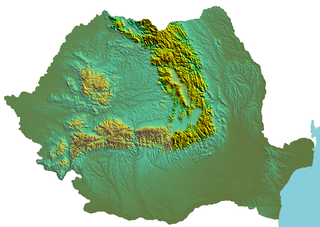 W
WThe Gurghiu Mountains are a range in the Căliman-Harghita Mountains of the Eastern Carpathians, Romania, in the Transylvania region. They cover an area of 581.76 km2 (224.62 sq mi).
 W
WThe Gutin Mountains are a mountain range within the Vihorlat-Gutin Area of the Inner Eastern Carpathians. They are centered in Maramureș County in Romania, bordering Satu Mare County, and also stretching further towards northwest as the Oaș Mountains, reaching border with Zakarpattia Oblast in Ukraine.
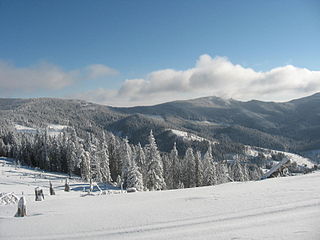 W
WThe Harghita Mountains is a volcanic mountain range of the Căliman-Harghita Mountains in Harghita County of Romania, part of the Inner Eastern Carpathians.
 W
WThe Hăşmaş Mountains, are limestone and sandstone massifs located in Romania in the Romanian Carpathian Mountain Range. The ranges include many cliffs and gorges, such as the Bicaz Gorge and the Panaghia Cliff.
 W
WThe Iezer Mountains are a mountain range in the Southern Carpathians in Romania. It is part of the Făgăraș Mountains group. Its total area is 535 km2 (207 sq mi). Its highest elevation is 2,470 m (8,100 ft), at Roșu Peak.
 W
WThe Lăpuș Mountains are a group of mountains in the Eastern Carpathians, located in the northern Romanian regions of Maramureș and Bukovina. The maximum elevation of these mountains is around 1,800m and a river also with the name Lăpuş runs through the valley.
 W
WThe Leaota Mountains are located in central Romania, north of the city Târgovişte. They are part of the Southern Carpathians group of the Carpathian Mountains, and have as neighbours the Bucegi Mountains to the east and Piatra Craiului to the west.
 W
WLotru Mountains are a group of mountains that are part of the Southern Carpathians, in Romania. The highest peak is Șteflești Peak at 2,242 metres (7,356 ft).
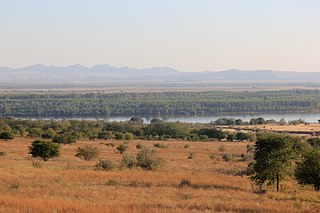 W
WThe Măcin Mountains is a mountain range in Tulcea County, Dobrogea, Romania. Part of the Northern Dobruja Massif, they are located between Danube River to the north and west, Taița River and Culmea Niculițelului to the east and Casimcea Plateau to the south. Seen from the Danube, they seem only low hills. However, they are a mountainous region.
 W
WThe Mehedinți Mountains are a mountain range in southwestern Romania, part of the Retezat-Godeanu Mountains group.
 W
WThe Moldavian-Muntenian Carpathians are a group of mountain ranges in Romania. These ranges are considered part of the Outer Eastern Carpathians. Within Romania, however, it is traditional to divide the Eastern Romanian Carpathians into three geographical groups, instead in Outer and Inner Eastern Carpathians:North: Carpathians of Maramureș and Bukovina - MMB; Centre: Moldavian-Transylvanian Carpathians - MMT; South: Curvature Carpathians - MC;
 W
WThe Oaș Mountains are a small volcanic mountain range within the Vihorlat-Gutin Area of the Inner Eastern Carpathians. The mountains are centered in northern section of the Oaș Country, covering border area between the Satu Mare County in Romania, and the Zakarpattia Oblast in Ukraine. They are an extension of the Gutin Mountains.
 W
WThe Pădurea Craiului Mountains are in the northwestern part of the Apuseni Mountains of the Carpathian Mountain range, located between the Vad-Borod Depression and Beiuş Depression. The Dealurile Vestice are located to the west of these mountains and the Vlădeasa Mountains are to their east. The highest peak in Pădurea Craiului is Hodrâncuşa at 1027 metres. The name Pădurea Craiului literally means "The Forest of the King".
 W
WThe Parâng Mountains are one of the highest mountain ridges in Romania and Southern Carpathians, with the highest peak, Parângu Mare, reaching 2,519 m.
 W
WThe Parâng mountain group is a subgroup of mountains in the Southern Carpathians. It is named after the highest of the mountains in the group, the Parâng Mountains.
 W
WThe Perșani Mountains is a mountain range in central Romania. The highest peak is Vârful Măgura Codlei, with an elevation of 1,292 metres (4,239 ft).
 W
WThe Piatra Craiului Mountains are a mountain range in the Southern Carpathians in Romania. Its name is translated as Kings' Rock or The Rock of the Prince. The mountain range is located in Brașov and Argeș counties; it is included in the Piatra Craiului National Park, which covers an area of 14,766 hectares (60 sq mi).
 W
WThe Piatra Mare Mountains is a small mountain range in Brașov County, southeast of Brașov, Romania, and also close to the resort town of Predeal.
 W
WThe Postăvarul massif is a massif in Romania; it is part of the Romanian Carpathians, which in turn are part of the Carpathian Mountains range. The altitude of the highest peak, also named Postăvarul is 1799 metres.
 W
WThe Retezat Mountains are one of the highest massifs in Romania, being part of the Southern Carpathians. The highest peak is Peleaga, at an altitude of 2,509 metres (8,232 ft). Other important peaks are Păpușa and Retezat Peak. The name means "cut off" in Romanian.
 W
WThe Retezat-Godeanu mountain group is a subgroup of mountains in the Southern Carpathians. It is named after the highest of the mountains in the group, the Retezat Mountains.
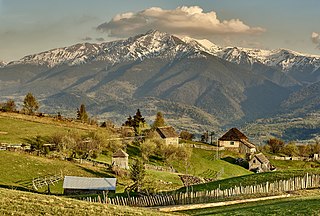 W
WRodna Mountains are a subdivision of the Inner Eastern Carpathians in Northern Romania. The name comes from the nearby Rodna Veche village.
 W
WThe Romanian Carpathians are a section of the Carpathian Mountains, within the borders of modern Romania. The Carpathians are a "subsystem" of the Alps-Himalaya System and are further divided into "provinces" and "subprovinces".
 W
WThe Sub Carpathians of Curvature, Ciucaș, or Curvature Carpathians, are located between Trotus Valley and Slanicul Buzaului Valley in Romania. They are a range of high hills, with knolls and parallel ridges, which separate two geologic depressions.
 W
WThe Şurianu Mountains,, Suriano in Italian, belong to Romania's Parâng range in the Southern Carpathians, with peaks frequently exceeding 2,000 metres.
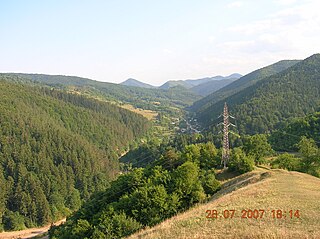 W
WThe Tarcău Mountains are a mountain range, part of the Moldavian-Muntenian Carpathians of the Outer Eastern Carpathians.
 W
WThe Țibleș Mountains are a volcanic mountain range located in Maramureș County, in northern Romania. They belong to the Vihorlat-Gutin Area of the Inner Eastern Carpathians.
 W
WThe Trascău Mountains are located in the Apuseni mountain range of the Western Romanian Carpathians, in Romania.
 W
WThe Vihorlat-Gutin Area is a region of mountain ranges spanning from eastern Slovakia, through western Ukraine, into northern Romania.
 W
WThe Vrancea Mountains are a mountain range in the Curvature Carpathians of eastern Vrancea County in Romania. The 1977 Vrancea earthquake had its epicentre there.
 W
WThe Vršac Mountains, also known as Vršac Hill, are located in the Banat region near the city of Vršac, Serbia and partially also in Romania. They represent an independent and distinct massif, 19 kilometers long and spreading on an area of 170 square kilometers, of which 122 belong to Serbia and 48 to Romania.
 W
WThe Western Romanian Carpathians, along with the Eastern Romanian Carpathians and the Southern Carpathians is one of the three main mountain ranges of Romania. Their name is given based on their geographical position, west, to the Transylvanian Plateau, which is simultaneously their eastern limits, respectively to the Timiș-Cerna Gap of the Banat Mountains, the southern group of the Western Carpathians.
 W
WThe term Wooded Carpathians refers to a group of mountain ranges that constitute the central section of Eastern Carpathians, covering both inner and outer regions of that section. Geographical scope of the term varies, since it is often used in broader or narrower sense, according to different classifications and terminological conventions. It is traditionally and most commonly applied to a wider group of mountain ranges that encompasses all mountains within central section of Outer Eastern Carpathians, including Eastern Beskids with Polonynian Beskids, and also all mountains within northern section of Inner Eastern Carpathians, including Vihorlat-Gutin Area and Maramureș-Rodna Area. In that sense, Wooded Carpathians are stretching from the southeastern corner of Poland and far eastern corner of Slovakia, through western parts of Ukraine, encompassing all of the Ukrainian Carpathians, and continuing into the northern region of Romania.